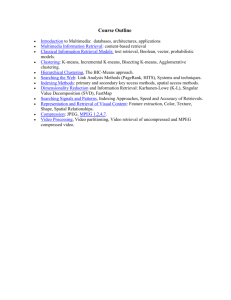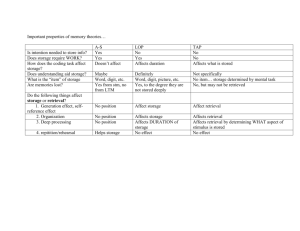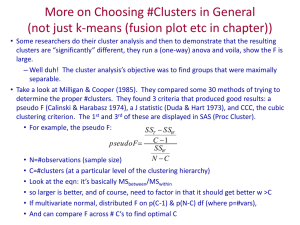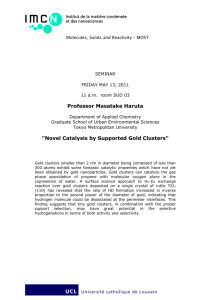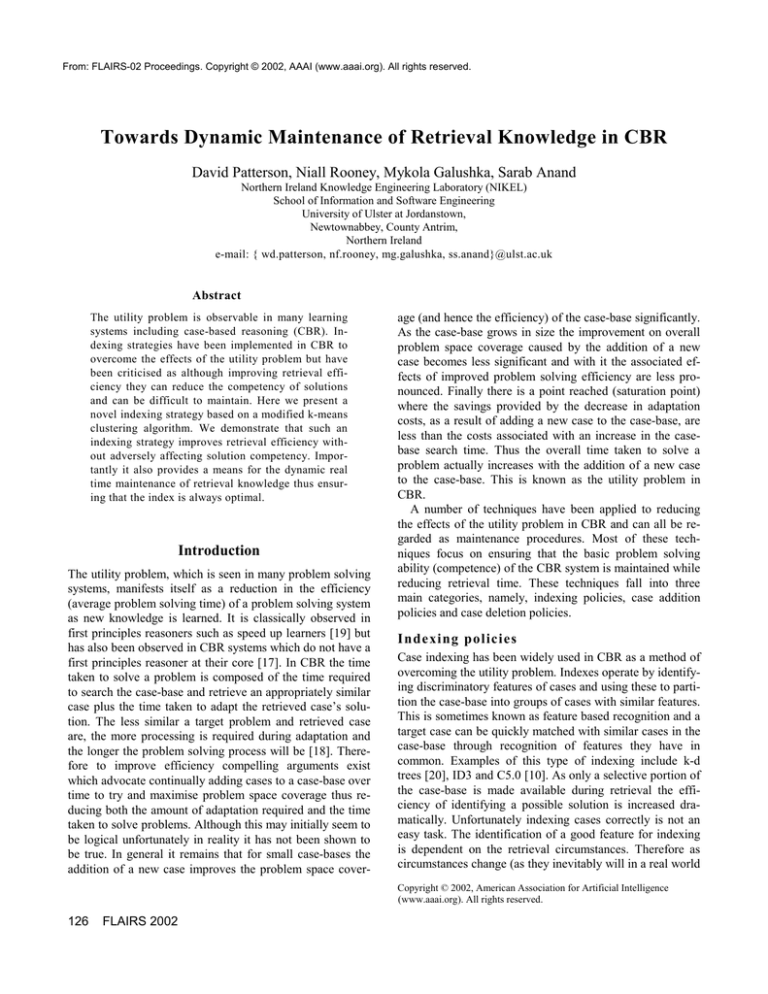
From: FLAIRS-02 Proceedings. Copyright © 2002, AAAI (www.aaai.org). All rights reserved.
Towards Dynamic Maintenance of Retrieval Knowledge in CBR
David Patterson, Niall Rooney, Mykola Galushka, Sarab Anand
Northern Ireland Knowledge Engineering Laboratory (NIKEL)
School of Information and Software Engineering
University of Ulster at Jordanstown,
Newtownabbey, County Antrim,
Northern Ireland
e-mail: { wd.patterson, nf.rooney, mg.galushka, ss.anand}@ulst.ac.uk
Abstract
The utility problem is observable in many learning
systems including case-based reasoning (CBR). Indexing strategies have been implemented in CBR to
overcome the effects of the utility problem but have
been criticised as although improving retrieval efficiency they can reduce the competency of solutions
and can be difficult to maintain. Here we present a
novel indexing strategy based on a modified k-means
clustering algorithm. We demonstrate that such an
indexing strategy improves retrieval efficiency without adversely affecting solution competency. Importantly it also provides a means for the dynamic real
time maintenance of retrieval knowledge thus ensuring that the index is always optimal.
Introduction
The utility problem, which is seen in many problem solving
systems, manifests itself as a reduction in the efficiency
(average problem solving time) of a problem solving system
as new knowledge is learned. It is classically observed in
first principles reasoners such as speed up learners [19] but
has also been observed in CBR systems which do not have a
first principles reasoner at their core [17]. In CBR the time
taken to solve a problem is composed of the time required
to search the case-base and retrieve an appropriately similar
case plus the time taken to adapt the retrieved case’s solution. The less similar a target problem and retrieved case
are, the more processing is required during adaptation and
the longer the problem solving process will be [18]. Therefore to improve efficiency compelling arguments exist
which advocate continually adding cases to a case-base over
time to try and maximise problem space coverage thus reducing both the amount of adaptation required and the time
taken to solve problems. Although this may initially seem to
be logical unfortunately in reality it has not been shown to
be true. In general it remains that for small case-bases the
addition of a new case improves the problem space cover-
age (and hence the efficiency) of the case-base significantly.
As the case-base grows in size the improvement on overall
problem space coverage caused by the addition of a new
case becomes less significant and with it the associated effects of improved problem solving efficiency are less pronounced. Finally there is a point reached (saturation point)
where the savings provided by the decrease in adaptation
costs, as a result of adding a new case to the case-base, are
less than the costs associated with an increase in the casebase search time. Thus the overall time taken to solve a
problem actually increases with the addition of a new case
to the case-base. This is known as the utility problem in
CBR.
A number of techniques have been applied to reducing
the effects of the utility problem in CBR and can all be regarded as maintenance procedures. Most of these techniques focus on ensuring that the basic problem solving
ability (competence) of the CBR system is maintained while
reducing retrieval time. These techniques fall into three
main categories, namely, indexing policies, case addition
policies and case deletion policies.
Indexing policies
Case indexing has been widely used in CBR as a method of
overcoming the utility problem. Indexes operate by identifying discriminatory features of cases and using these to partition the case-base into groups of cases with similar features.
This is sometimes known as feature based recognition and a
target case can be quickly matched with similar cases in the
case-base through recognition of features they have in
common. Examples of this type of indexing include k-d
trees [20], ID3 and C5.0 [10]. As only a selective portion of
the case-base is made available during retrieval the efficiency of identifying a possible solution is increased dramatically. Unfortunately indexing cases correctly is not an
easy task. The identification of a good feature for indexing
is dependent on the retrieval circumstances. Therefore as
circumstances change (as they inevitably will in a real world
Copyright © 2002, American Association for Artificial Intelligence
(www.aaai.org). All rights reserved.
126
FLAIRS 2002
environment) the indexing structure of the case base must
be maintained to reflect this. If the indexing scheme is poor
or maintenance is ignored, cases with perfectly good solutions to the target problem may be overlooked as they reside
in a different part of the case-base not accessible under the
current indexing scheme. This can lead to the complex adaptation of less suited cases, the reduction in competency
and in severe situations, problem solving failures. Therefore, due to poor indexing and a lack of good maintenance,
in an attempt to improve retrieval efficiency, competency is
often sacrificed [5]. Other problems with indexing strategies
include how to cope with cases with differing feature importances.
A number of researchers have applied indexing strategies
to CBR. Zhang & Yang [21] take an indexing approach to
reducing redundancy (a major contributor to the utility
problem) in case-bases, based on a neural network model.
Aha and Breslow [1] presented an (automated) methodology of continually refining a case-base library in the domain
of conversational case-base reasoning (CCBR) to improve
both competency and efficiency. Deangdej [2] devised a
dynamic indexing structure to retrieve cases at run time
from an insurance case-base of over two million cases. Fox
& Leake [3] developed an introspective reasoning technique
for dynamically refining case indexes based on previous
retrievals. Smyth has devised an indexing scheme based on
a case competence model [18] which improves retrieval
competency and efficiency. Another approach to fast case
retrieval are case retrieval nets [8]. The idea is to represent
the cases and their attributes as a network of interconnected
information entities. Starting with the query’s information
entities activated, a spreading activation algorithm is used to
retrieve the best matching cases. This has been used in tests
with case bases up to 35,000 cases.
Addition policies
Contradictions and inconsistencies within a case-base can
lead to degradation in performance for a case-base Racine
& Yang, [16]. As incomplete or incorrect cases are added,
the search overhead for similar cases from the case-base is
increased leading to decreased efficiency and poor or even
incorrect solutions will result. They advocate validating a
new case before it is added to the case-base during which
the user is warned of any possible problems and provided
with a means to correct the inconsistency. A novel case addition approach to maintaining competency in case-bases is
presented in CaseMaker [9]. Here the best case to add to a
developing case-base is selected based on an evaluation of
the additional coverage it provides. The case which provides the most additional coverage to the case-base is
added. Portinale et al. [14,15] also propose a system which
determines if a new case should be added to a case-base
using adaptability cost as a determinant measure. This strategy only adds a new case to the case-base if an old case
which was more expensive to adapt, is covered by the new
addition and can be deleted.
Deletion policies
In CBR deletion is a very difficult strategy to implement as
some cases are inevitably more expendable than others.
This is due to the fact that cases are the basic unit of both
competency and efficiency in a case-base [17,14]. For this
reason Classical deletion policies [11], despite their success
in combating the utility problem in machine learning, are
not easily transferable to CBR. This is because they were
designed with efficiency only in mind and can degrade the
competency of the case-base if not kept in check.
Techniques applied include the Footprint-Utility Deletion
Policy [18], which selects cases for deletion based on their
competence and utility (efficiency) contributions to the
case-base. Leake et al [6], propose an adaptation case deletion policy based on the number of times it has been used to
solve a problem. Hunt et al. [5] propose a system based on
the immune system designed to forget cases which were no
longer relevant to the problems being solved. This was
based on how relevant cases were to recent problems encountered and how relevant they were to other cases in the
case-base.
The research presented in this work revisits the indexing
approach to improving the efficiency of case-based problem
solving and forms part of the M2 CBR system [12]. This
was designed to create an architecture wherein the processes
of CBR knowledge discovery and maintenance could be
automated as much as possible. Here we examine the potential of implementing the k-means clustering algorithm to
define competent indexes in CBR. Clustering is an unsupervised data mining technique, whereby groups of cases (clusters) are formed, based on their degree of similarity. The
idea being that if they are similar they will have similar behaviours. When a target case, T, is presented, the cluster
centroid it is closest to is identified. This thereby selects the
cluster wherein T’s most similar cases most probably lie.
Retrieval is carried out on this identified cluster to provide
an estimate of a solution. The expectation is that this should
provide solutions of comparable competency to retrievals
on the entire case-base in the absence of clustering, but with
the added advantage of improvement in efficiency. This
expected efficiency improvement is because the retrieval
process only considers cases in one cluster at any time, thus
ignoring cases in the other clusters. This may lead to a possible method of reducing the effect of the utility problem in
CBR. The main concern constructing an index like this is
that poor classification of cases into clusters may lead to
degradation in competency if the clustering process is poor.
It is hypothesized that because we implement the same similarity metric to determine case cluster membership that is
used ordinarily when determining case similarity in an unindexed case-base, that the technique should not suffer from
same competency problems as feature based indexes and
retrieval competency should remain high. In this work simi-
FLAIRS 2002
127
Cases were retrieved from the case-base for the target case
using the nearest neighbour algorithm and 10 cross fold
validation. Using a voting scheme, the nearest neighbours
produced a predicted value for the target case’s output attribute field. The absolute difference between the predicted
value and the target case’s actual output field gave the absolute error. The Mean Absolute Error (MAE) was the average of absolute errors after cross fold validation.
The MAE and retrieval times produced from this process
were compared before and after clustering the case-base.
The cross validation process gave an indication of how
competent and efficient the case-base was at providing solutions for target problems. The MAE and retrieval times for
the unclustered case-base served as a benchmark to compare
the competency of the technique. In this experiment clustering was regarded as a one off start up cost and retrieval time
is the time taken to carry out the cross validation process
once the clusters were formed. In theory the retrieval time
should decrease with clustering as cross validation is only
occurring at an individual cluster level as opposed to the
entire case-base level as with the unclustered case-base.
Additionally the MAE should not be significantly different
as no extra similarity knowledge is used during clustering,
which could improve the retrieval process. If the clustering
process was not competent, that is cases were being placed
into clusters where they have little similarity to other cases
around them, then the MAE of the retrieval process would
deteriorate. This is a result of matching a target case with
similar cases in a cluster, which contains less relevant cases
than could be retrieved from the unclustered case-base. If
this were observed, even in the presence of improved retrieval times, the clustering approach to alleviating the utility problem would not be viable, as competency would have
to be sacrificed for efficiency. Five cases were retrieved
from the case-base during retrieval. The ‘solution’ of the
most similar case was revised using the four other cases
retrieved and their respective solutions, using a voting
scheme. Increasing numbers of clusters were formed from 2
to 10. One concern with clustering is that case-bases may be
forced into forming an unnatural number of clusters and it
was for this reason that the clustering algorithm permits the
formation of empty clusters. The case-base consisted of 565
cases and ten attributes taken from a housing domain sup-
128
FLAIRS 2002
Experimental Results
From Figure 1 it can be seen that as expected clustering
reduced the time taken for retrieval, as indicated by a decrease in cross validation time in the graph in Figure 1.
Note that one cluster equates to the unclustered case-base.
Cross validation time fell away sharply initially when forming 2 clusters and then continued to fall gradually but steadily providing evidence that retrieval was occurring using a
selection of fewer and fewer cases as defined by the clusters. This shows that Hypothesis 1, indexing using k-means
will improve retrieval efficiency compared to an unindexed
case-base, is correct. Also evident from the graph is that as
the number of clusters formed is increased the time taken
for clustering increases.
Clustering Cross Validation and Retrieval Tim es as
the Num ber of Clusters are Increased
1000
800
Time (ms)
Methodology
plied by the Valuation and Lands Agency of Northern Ireland. Of these ten attributes five were numeric and five were
categorical. The goal was to build a model for predicting
house price.
600
Clustering
400
X validation
200
Total
0
1
2
3
4
5
6
7
8
9 10
Num ber of Clusters
Figure 1 Graph showing change in clustering time, cross validation time and total retrieval time with increasing clusters.
Graph Show ing the MAE of Retrieval w ith
Increasing Clusters
6000
5000
MAE (£)
larity is calculated using its Euclidean distance, but it could
equally well be calculated based on adaptability or some
other measure There are two initial hypotheses tested in this
series of experiments.
Hypothesis 1 Indexing using k-means will improve retrieval efficiency compared to an unindexed case-base
Hypothesis 2 Indexing using k-means will have no significant effect on the competency of the overall solution
4000
3000
2000
1000
1
2
3
4
5
6
7
8
9
10
Num ber of Clusters
Figure 2 Change in MAE with clustering
Before this technique can be advocated as a possible
means of coping with the utility problem the competency of
the retrievals must be examined. Figure 2 shows how the
MAE of retrieval changed with increasing numbers of clusters. From this it can be seen that overall the MAE of re-
Discussion
The clustering approach to indexing case-bases seems to be
a promising one as efficiency is improved and competency
unaffected. With this model of retrieval the time expensive
process of clustering is considered as a one off start up cost,
carried out off line, whereby the case-base is clustered once
and many retrievals carried out on the clusters over time.
One of the fundamental concepts behind CBR as a problem
solving methodology is the intuitive manner in which new
case knowledge can be added to the case-base over time,
thus improving its problem solving capabilities. With the
indexing model as it stands new cases could simply be
added to the most appropriate cluster thus dispensing with
the need to recluster but a point will eventually be reached
whereby the cluster centroid is no longer a true reflection of
the cases it represents. Inevitably the case-base will need
reclustering to reflect the new case knowledge which has
been added. This can be viewed as part of the CBR maintenance activities [7]. If Figure 1 is observed a third curve
can be seen which shows what the total retrieval time would
be if clustering were considered as an integral part of the
retrieval process carried out in real time. That is if the casebase was reclustered as part of the overall retrieval process.
Integrating clustering into the retrieval process in CBR,
although attractive from a case-base maintenance perspective, only makes sense from the utility problem perspective
if the total retrieval time is less than the retrieval time for
the unclustered case-base. From Figure 1 it can be seen that
although the total retrieval time initially decreases with clus-
tering a point is reached at cluster 6 where the total retrieval
time is greater than retrieval time with an unclustered casebase. This is undesirable from the utility problem perspective because if more than 6 clusters are formed retrieval
time will increase. When examined in more detail the reason for the overall increase in retrieval time is due to the
fact that the savings produced by a reduction in cross validation time, as the number of clusters are increased, is less
than the increased cost of creating the clusters in the first
place. For this reason an optimised k-means algorithm was
developed which was designed to specifically speed up the
clustering process. The experiment was therefore repeated
replacing the basic k-means algorithm with an optimised kmeans algorithm. Here the data was initially partitioned into
10 subsets and k-means used to determine the number of
clusters within each partition. These centroids were then
placed into one group and k-means used to find the desired
experimental number of clusters between 2 and 10. Once
these were defined the cases in the case-base were placed
into their most closely matching cluster.
This algorithm is based on the idea that a lot of time is
spent making small changes to the final position of centroids and redistributing cases around them. These small
changes add little to the overall competency of the technique. Here an estimate of the cluster centers is quickly determined and cases grouped accordingly. It would be expected that a little bit of competency is sacrificed for improvement in efficiency. From Figure 3 it can be seen that
as before, cross validation time decreases as the number of
clusters formed increases. The curve is very similar to the
equivalent curve produced by the basic k-means algorithm
in Figure 1.
Clus te ring and Re tr ie val Tim e s as the Num be r of
Clus te rs are Incr e as e d
600
500
Time (ms)
trieval is very stable across all clusters. This is further
backed up by the results of a paired t-test which was designed to determine if the differences in MAE when forming
clusters was significantly different than the MAE in the absence of clustering. This showed that clustering has no statistically significant effect on the MAE of retrieval except
when forming 8 clusters (t=-3.218, 9 d.f., p=0.011).
Hypothesis 2 is therefore correct in that indexing using kmeans has no significant effect on the competency of the
overall solution. By way of investigating the quality of the
technique the identities of the 5 retrieved cases for each
target case were noted during cross validation in the absence of clustering and the percentage of times the same
cases were retrieved with clustering noted. When forming 2
clusters 98.9% of retrieved cases were identical, when forming 3 clusters 97.2% were identical, 4 clusters 96.4%, 5
clusters 96%, 6 clusters 96%, 7 clusters 96.5%, 8 clusters
95.5%, 9 clusters 95.7% and when forming 10 clusters
94.6% of retrieved cases are identical. These quality results
emphasise the competency of the clustering approach to
indexing as even when forming 10 clusters only 1 in every
20 retrieved cases is different than in the absence of clustering.
400
Cluster
300
X V alidation
200
Total
100
0
1
2
3
4
5
6
7
8
9 10
Num be r of Clus te r s
Figure 3 Time Graph showing change in clustering time, cross
validation time and total retrieval time with increasing numbers of
clusters using the optimised k-means algorithm.
This is expected as it reflects the cross validation process
within the formed clusters and unless the number of cases in
each cluster was drastically different then the times should
be very similar. This is encouraging as it shows that the
optimised k-means is forming clusters of a similar size as
the basic k-means. Also shown on this graph is the cluster-
FLAIRS 2002
129
ing time. This curve increases almost linearly but the time
taken to form the individual clusters is notably faster. In fact
it is almost twice as fast as the basic k-means algorithm at
forming clusters. The overall effects of this can be observed
from the total time curve which shows that for all clusters
formed the total retrieval time is always less than the retrieval time for the unclustered case-base. This is an important observation as it means that retrieval knowledge maintenance can be carried out routinely as an integral part of
case retrieval and the case-base is guaranteed to be in optimal condition from an efficiency perspective.
As with the initial experiment using the basic k-means
algorithm it is vital that the competency of the CBR system
is not adversely affected by the retrieval process. Figure 4
shows the MAE of retrieval as the number of clusters are
increased using both the basic and optimised k-means algorithms. From this it can be seen that the competency of the
optimised k-means is very stable and almost identical to the
basic algorithm.
Graph Showing the MAE of Retrieval with Increasing
Clusters Using the Basic and Optimised k-means
Algorithms
6000
MAE (£)
5000
4000
Basic k-means
3000
Optimised kmeans
2000
1000
1
2
3
4
5
6
7
8
9
10
Num ber of Clusters
Figure 4 Graph of change in MAE with clustering using both the
basic and the optimsied k-means algorithms
These results are further backed up by the results of a
paired t-test. This showed that clustering has no statistically
significant effect on the MAE of retrieval except when
forming 8 clusters (t=-4.022, 9d.f., p=0.001). It is interesting to note that both clustering algorithms produce statistically significant differences in MAE when forming 8 clusters and the reasons behind this need further investigation.
If the percentage of cases retrieved during cross validation using this technique is compared to the unclustered
case-base is examined it can be seen that when forming 2
clusters 96.4% of retrieved cases were identical, when forming 3 clusters 94.9% were identical, 4 clusters 90.3% were
identical, 5 clusters 90.3%, 6 clusters 88.6%, 7 clusters
87.3%, 8 clusters 85.3%, 9 clusters 83.7%, and when forming 10 clusters 83.6% of retrieved cases were identical.
These quality results although not quite as high as the basic
k-means results are still very competent as even in the worst
case, with 9 or 10 clusters, more than 4 of every 5 cases
used in retrieval are identical. This shows that the optimised
algorithm provides solutions of almost as high a quality as
130
FLAIRS 2002
the basic algorithm with respect to clustering (especially
when forming smaller numbers of clusters) but has the additional benefit of being almost twice as fast. It is felt that
optimising the attribute weights or facilitating overlapping
clusters will improve the optimised k-means approach with
respect to the quality of retrievals.
Conclusions
The k-means algorithm has been shown to be an efficient
and competent indexing approach to retrieval in CBR and
therefore a possible solution to the effects of the utility
problem. Two models were proposed in this work. The first
proposed clustering as a one off start up cost with retrieval
being carried out on the produced clusters. This leads to
very efficient retrieval times with no loss in competency.
Maintaining such a system can be problematic as new cases
when added to the case-base destabilise the formed clusters
leading to a loss in competency over time. To recluster each
time an addition is made is not time efficient. The case –
base would only have to be reclustered after N additions,
where the size of N is case-base dependent. A second
model which used a modified k-means algorithm was then
presented whose clustering time was half that of the basic kmeans algorithm. This approach enabled clustering ( retrieval knowledge maintenance) to be done, if necessary, in
real time as an integral part of retrieval and still provided
more efficient retrievals than those from an unclustered
case-base whilst maintaining retrieval competency.
A non reductionist approach to case-base maintenance,
such as the one proposed here, has a number of benefits
over the reductionist approach [16,9]. Firstly the large start
up cost of sorting cases into order of increasing competence
is not necessary. Additionally cases are maintained in the
case-base thereby making them available to improve other
tasks within the CBR system. For example it is widely recognised that knowledge can be moved from one knowledge
container to another. Hanney [4] demonstrates how adaptation knowledge can be discovered from case knowledge.
Additionally Patterson [13] has shown how similarity
knowledge can be automatically generated from case
knowledge. When cases are removed from the case-base to
make them as compact as possible a lot of knowledge can
be lost. What is proposed here is a model wherein all case
knowledge can be maintained in the case-base with a view
to utilising it to improve the competency, efficiency and
maintainability of the entire CBR system. We envisage that
each cluster will be representative of localised areas of
competency. Therefore they should be used to discover their
own specific adaptation and similarity knowledge containers
as opposed to using more general high level and less specific case-wide knowledge containers.
Future work includes experimenting with a number of
case-bases; investigating the effects of optimising the attrib-
ute weights and the effects of allowing overlapping clusters
on the efficiency, competency and quality of the clustering
process. It is envisaged that these steps will improve the
quality of cases retrieved using optimised k-means. Additionally the discovery of cluster specific adaptation and
similarity knowledge will be investigated.
References
1 Aha, D. W. and Breslow, L. Refining conversational case
libraries. In Proceedings of the 2nd International Conference
on Case-based Reasoning, ICCBR-97, pp 267-276, Providence RI, USA, 1997.
2 Deangdej, J., Lukose, D., Tsui, E., Beinat, P. and Prophet,
L. Dynamically creating indices for two million cases: A
real world problem. In Smith, I. And Faltings, B. eds., Advances in Case-Based Reasoning, Lecture Notes in AI,
.Springer-Verlag. 105-119. Berlin: Springer Verlag 1996.
3 Fox, S. and Leake, D.B. Using Introspective reasoning to
refine indexing. In Proceedings of the 14th International
Joint Conference on Artificial Intelligence. Montreal, Canada, August , pp 391-387.,1995.
4 Hanney, K. and Keane M. Learning Adaptation Rules
from a Case-Base, Proc. Advances in Case-Based Reasoning, 3rd European Workshop, EWCBR-96, pp179-192,
Lausanne, Switzerland, November 1996.
5 Hunt, J.E., Cooke, D.E. and Holstein, H. Case-memory
and retrieval based on the immune system. 1st International
Conference on Case-Based reasoning (ICCBR-95), pp 205216, 1995.
6 Leake, D. B., Kinley, A. and Wilson, D. A Case Study of
Case-Based CBR. In Proceedings of the Second International Conference on Case-Based Reasoning. Berlin.
Springer, pp.371-382, 1997.
7 Leake, D.B. and Wilson, D.C. Categorizing Case-Base
Maintenance: Dimensions and Directions. In Advances in
CBR: Proceedings of European Workshop on Case-Based
Reasoning, Berlin, Springer-Verlag, pp 196-207, 1998.
8 Lenz, M., Burkhard, H.D. Case Retrieval Nets: Basic
Ideas and Extensions: In Gorz G., Holldobler S. (eds): KI96, Advances in Artifical Intelligence Springer Press 1996.
9 McSherry, D. Automating case selection in the construction of a case library. Proceedings of ES99, the19th SGES
International Conference on Knowledge-Based Systems and
Applied Artificial Intelligence, Cambridge, pp 163-177,
December 1999.
10 Michalski, R.S.; Bratko, I. And Kubat, M. Machine
Learning and Data Mining: Methods and Applications.
John Wiley and Sons LTD 1999.
11 Minton, S. Quantitative results concerning the utility of
explanation based learning. Artificial Intelligence, 42, pp
363-391, 1990.
12 Patterson, D., Anand, S.S., Dubitzky, D. and Hughes,
J.G. Towards Automated Case Knowledge Discovery in the
M2 Case-Based Reasoning System, Knowledge and Information Systems:An International Journal, (1), pp 61-82,
Springer Verlag, 1999.
13 Patterson, D., Anand, S.S., Dubitzky, D. and Hughes,
J.G. A Knowledge Light Approach to Similarity Maintenance for Improving Case-Based Competence. Workshop
on Flexible Strategies for Maintaining Knowledge Containers 14th European Conference on Artificial Intelligence,
ECAI 2000.
14 Portinale, L., Torasso, P. and Magro, D. Dynamic Case
Memory Management, Proc. ECAI 98, pp. 73-78, John
Wiley and Sons, Brighton, 1998.
15 Portinale, L., Torasso, P. and Magro, D. Speed up quality and competence in multi model reasoning Proceedings
of the 3rd International Conference in Case-Based Reasoning, pp 303-317, 1999.
16 Racine, K. and Yang, Q. Maintaining unstructured casebases. In the Proceedings of the 2nd International Conference on case-Based Reasoning, ICCBR-97, pp 553-564,
Providence, RI, USA, 1997.
17 Smyth, B. and Keane, M. Remembering to Forget.: A
Competence-Preserving case Deletion Policy for CaseBased Reasoning Systems. In Proceedings of 14th IJCAI,
pp377-382, 1995.
18 Smyth, B. and McKenna, E. Footprint-based retrieval.
Proceedings of the 3rd International Conference on CaseBased Reasoning, Munich, Germany, pp 343-357, July
1999.
19 Tadepalli, P. A. theory of unsupervised speedup learning. Proceedings of the 12th National Conference on Artificial Intelligence (AAAI-92), pp 229-234, 1992.
20 Weiss, S., Althoff, K-D., Derwand,, G. Using k-d trees
to improve the retrieval step in case-based reasoning. In
topics in case-based reasoning. Lecture notes in Artificial
Intelligence, Vol. 837. Springer-Verlag, Berlin Heidelberg
New York, pp 167-181, 1994.
21 Zang, Z. and Yang, Q. Towards lifetime maintenance of
case-based indexes for continual case-based reasoning. In
Proceedings of the 8th International Conference on Artificial
Intelligence: Methodology, Systems, Applications, Sozopol,
Bulgaria, 1998.
FLAIRS 2002
131

